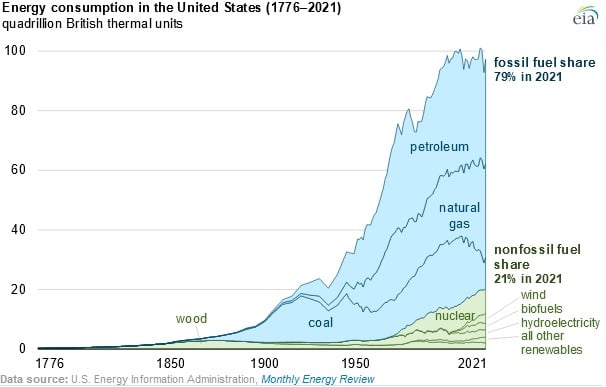U.S. Energy Consumption Recorded Largest Annual Increase in 2021: EIA

U.S. primary energy consumption, which includes energy from fossil fuels, renewables, and nuclear, increased by 4 quadrillion British Thermal Unit (quads) in 2021 as compared to 2020, according to a July 1 report from the U.S. Energy Information Administration. Fossil fuels namely, petroleum, natural gas, and coal, represent approximately 76.6 quads out of the total 97 quads. This translates to 79 percent U.S. dependency on fossil fuels during the year 2021.
This increase in energy consumption is mainly due to the restoration of activities post pandemic. During the pandemic, there was a dip of 7 quads in 2020 which was the largest annual decrease in records. There was an increase in renewable energy consumption from 11.5 quads to 12.2 quads from 2020 to 2021. There was a decline observed in hydroelectricity generation due to increased use of wind and solar energy for electricity generation. U.S. nuclear energy consumption had also been on the lowest level of 8.2 quads in 2020 which had marked the lowest level since 2012.
Petroleum takes the privilege to be the most-consumed primary energy source in the U.S. since 1950 where it surpassed coal consumption in 1950. The peak consumption of petroleum had dipped as compared to its peak in 2005, which totals 35 quads consumption in 2021. The natural gas utilization was slightly less than year 2021 that is 31.3 quads. The coal consumption marked its first increase in annual consumption since 2013 and went up to 10.5 quads in 2021. However, U.S. usage of coal has reduced to half since the 2005 peak due to shifting of coal based electricity generation power plants to other resources.
EnerKnol Pulses like this one are powered by the EnerKnol Platform—the first comprehensive database for real-time energy policy tracking. Sign up for a free trial below for access to key regulatory data and deep industry insights across the energy spectrum.
ACCESS FREE TRIAL